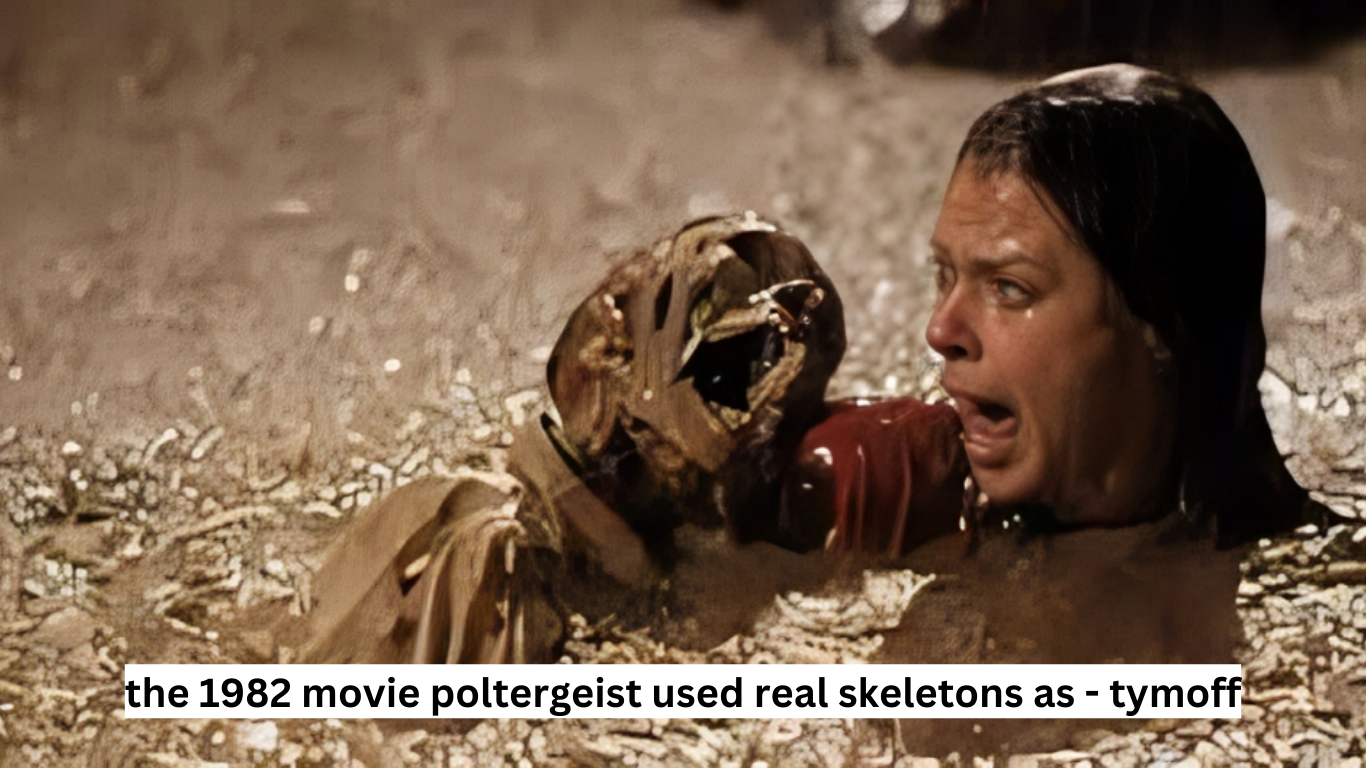Have you ever watched a movie that left you with chills long after the credits rolled? the 1982 movie poltergeist used real skeletons as – tymoff horror classic, Poltergeist, is one such film. However, behind the scenes of this iconic movie lies a controversial secret that has shocked audiences for decades. Join us as we delve into the spine-tingling tale of how real skeletons were allegedly used during the making of Poltergeist. Brace yourself for a bone-chilling journey into Hollywood’s dark side!
The Making of Poltergeist

When it comes to the making of the the 1982 movie poltergeist used real skeletons as – tymoff there’s a blend of creativity and controversy that swirls around its production. Directed by Tobe Hooper and produced by Steven Spielberg, this horror classic brought together a talented cast and crew to bring the chilling story to life. From the iconic special effects to the eerie set designs, every aspect of the film was meticulously crafted to capture audiences’ imaginations.
The behind-the-scenes stories from filming Poltergeist reveal a mix of excitement and tension on set as everyone worked tirelessly to create something truly groundbreaking. The dedication and passion of those involved in bringing this supernatural tale to fruition is evident in every frame of the movie. The legacy of Poltergeist lives on, not just for its scares but also for its impact on future horror films that followed in its footsteps.
The Allegations of Real Skeletons Being Used
When it comes to the horror classic “Poltergeist” from 1982, there’s a chilling controversy that has lingered over the years. Rumors swirl around the use of real human skeletons in certain scenes of the film. These unsettling allegations have sparked debate among fans and critics alike.
Some claim that due to budget constraints, the production opted for authentic skeletons instead of prop bones. This macabre choice added an eerie authenticity to the movie but also raised ethical concerns within the industry.
Despite these accusations, concrete evidence proving or disproving this theory remains elusive. The mystery surrounding whether real skeletons were used in “Poltergeist” continues to intrigue and unsettle those fascinated by behind-the-scenes Hollywood secrets.
Confirmation from Cast and Crew Members
When the controversy surrounding the use of real skeletons in the 1982 movie “Poltergeist” surfaced, many were skeptical. However, cast and crew members have come forward to confirm these unsettling claims.
Actors such as JoBeth Williams and Zelda Rubinstein have revealed that they indeed worked with real skeletons during certain scenes. They shared their shock at discovering this fact while on set, adding another layer of mystery to the film’s production.
Similarly, behind-the-scenes personnel like special effects artist Craig Reardon have also verified the use of authentic human remains for certain sequences. This revelation has sparked further discussions about ethical boundaries in filmmaking practices.
The confirmation from those directly involved in creating “Poltergeist” adds a chilling element to an already eerie narrative, leaving audiences questioning what other secrets may lie within Hollywood’s shadows.
How This Controversy Affected the Film’s Legacy
The controversy surrounding the use of real skeletons in the 1982 movie poltergeist used real skeletons as – tymoff had a lasting impact on its legacy. Fans and critics alike were shocked by the revelation that actual human remains may have been used during filming, adding an eerie layer to an already chilling story.
Despite the controversy, Poltergeist remains a cult classic in the horror genre. The film’s unsettling atmosphere and groundbreaking special effects continue to captivate audiences decades later. However, for some viewers, knowing about the alleged use of real skeletons casts a shadow over their enjoyment of the film.
The debate around ethical boundaries in filmmaking sparked by this revelation has lingered throughout the years. It serves as a reminder of the importance of transparency and respect for human dignity in all aspects of art and entertainment. Politically correct or not? That’s up for each viewer to decide when watching this iconic horror flick with newfound knowledge about its production history.
Similar Cases in Other Movies
Did you know that the use of real skeletons in movies is not limited to just Poltergeist? In fact, there have been similar cases in other films throughout cinematic history.
One notable example is the 1978 movie “Dawn of the Dead,” where real cadavers were used as props in some scenes. This decision sparked controversy and raised ethical concerns within the film industry.
Another instance occurred during the production of “The Texas Chainsaw Massacre” in 1974, where animal remains were utilized for authenticity. The realism achieved came at a cost, prompting discussions about boundaries in filmmaking.
“Indiana Jones and the Temple of Doom” drew criticism for cultural insensitivity, particularly its use of real monkey brains.
These instances highlight the blurred lines between artistic vision and moral considerations within the realm of cinema.
Ethical Considerations in the Film Industry
Ethical considerations are crucial in shaping how films are made and perceived by audiences in the industry.
One of the key ethical dilemmas faced by filmmakers is deciding where to draw the line between artistic expression and respecting human dignity. Using real skeletons in a movie, like in the case of Poltergeist, raises questions about how far creators should go in pursuit of authenticity.
Ensuring that all individuals involved in the production process are treated fairly and with respect is paramount. From actors to crew members, everyone deserves to work in an environment free from exploitation or harm.
Another aspect of ethics in filmmaking involves accurately representing diverse perspectives and cultures on screen. Filmmakers must handle sensitive topics with empathy, mindful of impacts on marginalized communities from their portrayals.
In the film industry, ethical navigation demands reflection and a commitment to human values above all else.
FAQs
Were real skeletons truly used in Poltergeist?
Yes, it has been confirmed by cast and crew members that actual human remains were utilized during filming.
Why were real skeletons chosen for the movie?
The decision to use authentic bones was made due to budget constraints and a desire for realism in certain scenes.
Did the use of real skeletons affect the actors on set?
Reports suggest cast discomfort working with genuine remains, adding an eerie element to their performances on set.
Have similar controversies arisen in other films throughout cinematic history?
Filmmakers’ unconventional prop choices spark industry and audience debates, addressing the use of unconventional materials.
What ethical considerations should be taken into account when creating movies?
Artistic intentions must be weighed against ethical implications, ensuring respect for human dignity with sensitive materials.
Conclusion
the 1982 movie poltergeist used real skeletons as – tymoff using real skeletons remains a disturbing yet intriguing aspect of its legacy. Though adding authenticity, it prompts ethical questions on human remains’ treatment in the film industry. Despite the controversy, “Poltergeist” endures as a timeless horror classic, undiminished by its production’s dark cloud. Viewers ponder the extent filmmakers should push realism and if such practices merit approval or condemnation in cinema.


